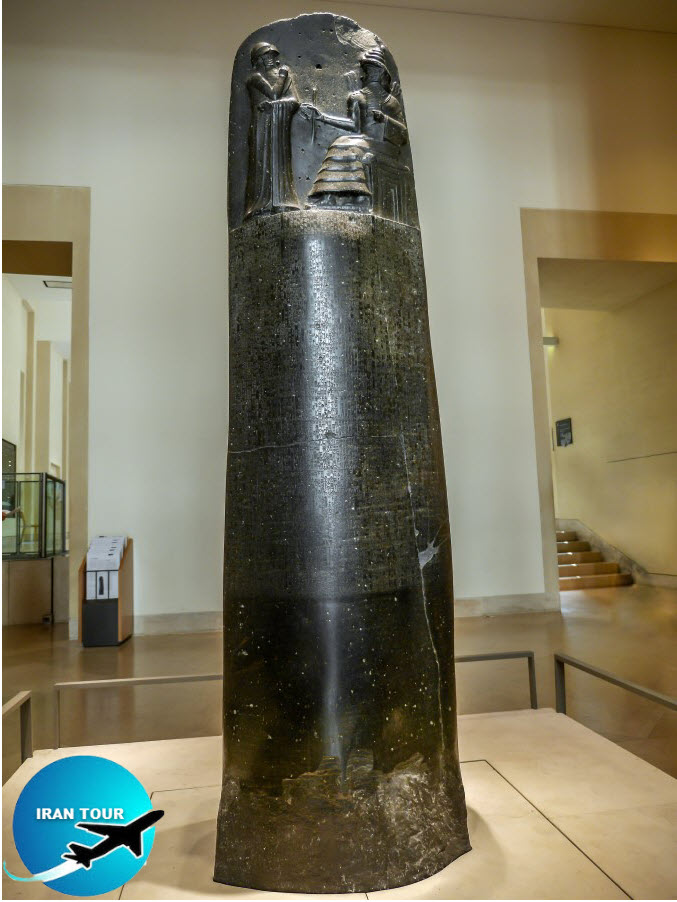Copyright 2020 - 2021 irantour.tours all right reserved
Designed by Behsazanhost
The Law Code of Hammurabi
The Law Code of Hammurabi
In the first-floor gallery of Iran National Museum, you encounter a replica of the world-famous Hammurabi Law Code.
The original, which is a basalt stele, 2.25 meters high, bears the most lengthy single text survived from the Old Babylonian Period. This collection of laws was long thought to be the first legal text in history, but this theory is disputed now by the discovery of older collections of laws, respectively those of Uru-
 |
Laws of Lipit-Ishtar (1934-1924 B.C.) king of Isin and Laws of Eshnunna, all of which were discovered and translated after introducing the Law code of Hammurabi.
Hammurabi (1792-1750 B.C.), also spelled Hammurapi, was the sixth ruler of the Amorite Dynasty of Babylon. He raised Babylon from a minor city-state to cultural and economic supremacy in the Near East which lasted for the next two thousand years. Hammurabi erected this monument most probably to gain the satisfaction of gods and preserve name and deeds on preserve name and deeds of himself.
The Laws are carved in 49 columns and sandwiched between a prologue and epilogue in a rhyming and literary style giving the titles and achievements of Hammurabi and proclaiming the authority of his laws. The middle section is divided into 282 codes of law by modern scholars and the subject matter of them is:
Administration of justice
1-5 False witnesses; corrupt judges.
Offenses against property 6- 14 Theft, including the kidnapping of a minor.
15 - 20 Runaway and stolen slaves.
21 - 25 Housebreaking, robbery, looting.
Land and houses
26 - 41 Tenure of land held as a fief from the king.
42 - 48 Cultivation of arable land by tenants.
49 - 52 Regulations governing the financing of tenant-farmers.
53 - 56 Offences arising from negligent irrigation.
57 - 58 Trespass of cattle on corn-land.
59 Unauthorized cutting of trees.
60 - 65&A Cultivation of
Merchants and agents
L. R Loans from merchants; interest rates.
S,T (Fragmentary].
U Division of profit and loss between partners.
100 - 107 Regulations governing transactions of merchant agents.
108 - 111 Regulations concerning (female) inn-keepers, (who apparently also served as small brokers).
112 Fraud by a carrier.
113 - 117 Distraint for debt.
118 - 119 Delivery of dependents into bondage for debt.
120 - 126 Deposit of goods.
 |
Women, marriage, family property and inheritance
127 Slander of high-priestess or married woman.
128 Wifehood; cohabitation without
give a woman the status of wife.
129 - 132 Adultery.
133 - 136 Remarriage of a wife: this is permitted in the
husband's absence only in certain circumstances, though unconditionally for voluntary desertion.
137 - 143 Divorce.
144. 149 Concubinage: and a circumstance in which bigamy is permitted. Inheritance of property settled by husband on
150 wife.
151 - 152 Liability of spouses for debt.
153 Penalty for the wife who murders her husband impalement
154 - 158 Incest.
159 - 161 Breach of contract after betrothal.
162 - 164 Disposal of dowry after the death of wife.
165 - 167 Division of inheritance amongst sons.
168 - 169 Disheriosn.
170 Legitimation of sons of the concubine.
171 - 174 Rights of
175 - 176 Rights of a free woman married to a slave.
177 Disposal of
178 - 184 Rights of cult women to dowry or paternal inheritance.
185 - 193 Adoption.
194 Substitution of changeling by a wet nurse.
Assault and personal injury
195 Assault by a son on his father.
196 - 205 Penalties for inflicting bodily harm-talion when the victim is a freeman, a fine when he is a
Professional fees and responsibilities
215 - 225 Fees payable to surgeons and veterinary surgeons for successful operations, and penalties incurred where
226 - 227 Penalties for excising or procuring the excision of a slave mark.
228 - 239 Fees for builders and shipmasters and penalties for negligence. 240 Collision between a galley and a sailing ship.
Agriculture
241 - 249 Distraint, hire death and injury of oxen.
250 - 252 Responsibility for damage by a goring ox.
253-256 Wrongful conversion by a bailiff.
257 - 258 Hire of
259 - 260 Theft of agricultural implements.
261 Hire of stockman or shepherd.
Rates of hire
268 - 277 Rates of hire of animals, wagons,
Ownership and sale of slaves
278 - 279 Liability for
sickness or subject to a legal claim.
280 - 282 Re-claiming of slaves bought abroad and returned to Babylonia. (List after Saggs, 1962,207-9).
- Details
- Category: IRAN Blog